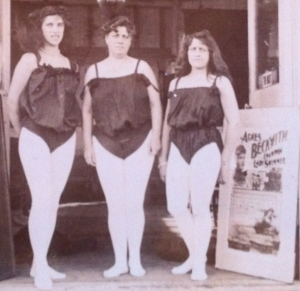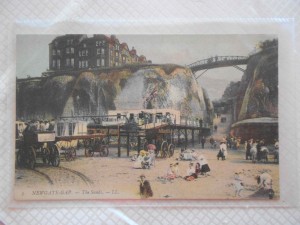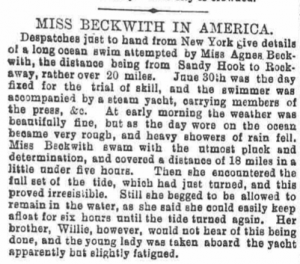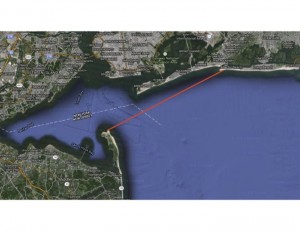 Unbound, September 1st, 2018
Unbound, September 1st, 2018
‘A thrilling tale of female courage and love, beautifully told,’ Maggie Gee
‘A great slice of history, a feisty woman, and lots of swimming – what’s not to love?’ Jenny Landreth, author of Swell: A Waterbiography
‘Daisy Belle has the passion, greed and romance of all good stories, but with that lovely swimming element that makes you want to dive in,’ Ella Foote, Outdoor Swimmer Magazine
‘Daisy Belle is a love letter to a forgotten golden age of swimming,’ Anna Morell, the Outdoor Swimming Society
‘A charming, empowering novel based on a true story’, Bookbub
Watch/Listen to a talk on the historical figures behind the story of Daisy Belle, filmed during Manchester Metropolitan University’s Sports and Leisure Symposium and now published on Playing Pasts.
ORDER FROM HIVE. ORDER FROM AMAZON. ORDER FROM FOYLES ORDER FROM WATERSTONES
The history behind the book
Over the past few years, I’ve read quite a bit about Agnes Beckwith, the teenage Victorian swimming champion. I first came across her when I was researching Taking the Waters: A Swim Around Hampstead Heath and then more recently while working on Downstream: a history and celebration of swimming the River Thames.
But it’s one thing writing about women like Agnes – whose feats were once famous and widely reported and who are largely unheard of today – in non-fiction, quite another in a novel. In a non-fiction book you can devote perhaps a few pages to each woman whose history has been lost…but in a novel you can devote the entire book.
That’s what made me want to write a fictionalised life story based on the careers of several Victorian swimmers, including Agnes Beckwith, Emily Parker and Annie Luker. My character is called Daisy Belle, born in Margate in 1863, she becomes ‘champion lady swimmer of the world.’

Agnes Beckwith (centre) and two members of her ‘troupe of lady swimmers’ Image provided by Ian Gordon
Agnes Beckwith was born in Lambeth, south London, in the summer of 1861. Her father was ‘English professional champion’ Frederick Beckwith, swimming professor at the Lambeth Baths.
His ‘family of frogs’ started giving public displays in the early 1860s and in 1865 he included Agnes. By the time she was nine, she was performing in Paris with her brother Willie.
In September 1875, at the age of 14, Agnes made history by swimming the River Thames from London Bridge to Greenwich. She went on to become Champion Lady Swimmer of the World.
This is how I set about writing Daisy Belle…..

The Lambeth Baths
I have a folder bursting with Victorian newspaper sports reports covering Agnes’ various swims, but what’s proving hard is trying to build up a picture of what the Lambeth Baths were like and how aquatic galas were run.
At the Lambeth Archives I look through local history books, and yet more newspaper clippings, until at last I find a design for the baths and wash-houses. Now I can see there were two pools – first and second class – surrounded by dressing boxes. There’s a boiler house, waiting rooms (according to class), a pay office and a library.
The First Class Swimming Bath looks so elegant, with a fountain in the middle and staircases leading up to the private ‘slipper baths’. But as the pools would have been men only, where would Agnes have swum?
The Lambeth Archives have posted some photos of the baths online, but when I ask if I can see the originals I’m told, ‘we don’t like to take them out too much.’
The Baths opened in July 1853, built behind 156 Westminster Bridge Road between Oakley Street and Lambeth Marsh. They were considered the best in London when it came to competition swims and were said to be ‘the largest indoor swimming pool complex’ in the world at the time.
They were run by the Lambeth Baths & Washhouses Company, a first class swim cost 6d and second class cost 3d. Large bathing establishments had at least a dozen staff, including:
- Superintendent
- Matron
- Engineer
- Stoker x 2
- Bath attendants – usually around 5 male and 1 female – all expected to be expert swimmers
- Two money takers
- Towel washers – 1 pool meant washing up to 2000 towels a week
Like other baths, in winter months the Lambeth Baths were used as a men’s gym and for other events. On Christmas Eve 1878, for example, spectators could watch two men – Perkins and Thatcher – who would ‘Walk against Time’ for a wager of £50. The duo had already ‘undertaken the unprecedented Feat of Walking 21 Miles in One Hour and a half between them.’
Then on Boxing Day the entertainments included climbing a greasy pole for a sucking pig, a race in sacks and a grand sparring display.
‘There is a natural analogy between the ablution of the body and the purification of the soul,’ Bishop Taylor (Baths and Wash Houses by George A Cape, 1854)
I leave the archives and head north to Westminster Bridge Road to try and find where the baths once were, with the entrance believed to be behind today’s Waterloo Health Centre. The scene is mostly shiny office blocks and apartments, but there are some signs of the Victorian past with a church, pubs, and the sound of trains rattling above on the railway.
I immediately decide my character’s father will spend a lot of time at the Crown & Cushion Public House, on the opposite side of the road, drinking ale and issuing swimming challenges
I walk the way Agnes may have walked to the River Thames, under the railway, past St Thomas’ Hospital…and then onto Westminster Bridge towards the golden tower of Big Ben.
 If I’m going to set some of the novel at the Lambeth Baths then I decide Channel champion Captain Matthew Webb has to have at least a walk on part. In August 1875 he became the first person to swim the English Channel unaided, and did some of his training at the baths under the direction of Professor Beckwith. Four years later Webb took part in the Trials of Endurance, a swimming pool competition that lasted six days.
If I’m going to set some of the novel at the Lambeth Baths then I decide Channel champion Captain Matthew Webb has to have at least a walk on part. In August 1875 he became the first person to swim the English Channel unaided, and did some of his training at the baths under the direction of Professor Beckwith. Four years later Webb took part in the Trials of Endurance, a swimming pool competition that lasted six days.
Webb competed against five other professional swimmers, with the aim being to swim as far as possible in 14 hours of swimming per day from Monday morning until Saturday night. Webb won of course, swimming 74 miles, but appears to have been near collapse. An illustration from the time shows a rope was used to separate the remaining two contestants, which appears to be the first time a lane divider was used in a competition.
But what really gets my interest is a report that Agnes Beckwith sometimes joined in the swimming race in the afternoons ‘to the enjoyment of the large crowds that gathered to watch the proceedings.’ I know this has to be a scene in the novel, my fictional heroine Daisy Belle swimming with the great Captain Webb.
Field trip to Margate
While Agnes Beckwith was born in London, my character will be from Margate in Kent. It seems a likely place for a swimmer to be born, and after all her father Professor Beckwith was from nearby Ramsgate. Margate was one of the first English seaside holiday spots, with sandy beaches and a pier, as well as the first purpose-built sea water bathing facilities. It was also a Margate man who invented the canvas ‘modesty’ screen that fitted to the back of a bathing machine. I haven’t been to Margate since I was a teenager and I’m stunned by the landscape.
Strolling around the harbour and the old town, and then along the coast to Cliftonville, there are plenty of reminders of Margate’s Victorian past
 When I go to the Margate Museum, in the old town’s Market Place, I’m incredibly lucky not only to have chosen a day when it’s open but even better to be introduced to Ian Dickie, chair of the friends of the museum. He takes me around the beautiful museum which is run by volunteers, giving me a lively potted history of the town, answering numerous questions and showing me boxes and boxes of Margate archives.
When I go to the Margate Museum, in the old town’s Market Place, I’m incredibly lucky not only to have chosen a day when it’s open but even better to be introduced to Ian Dickie, chair of the friends of the museum. He takes me around the beautiful museum which is run by volunteers, giving me a lively potted history of the town, answering numerous questions and showing me boxes and boxes of Margate archives.
 The Museum is housed in the second oldest building in Margate, which has served as the town hall, police station and magistrates’ court. Displays show how the place evolved from a small farming and fishing village, to a salt water resort for royalty and the wealthy and then, with the arrival of the paddle-steamers and railway, ‘a seaside resort for the working man and his family.’
The Museum is housed in the second oldest building in Margate, which has served as the town hall, police station and magistrates’ court. Displays show how the place evolved from a small farming and fishing village, to a salt water resort for royalty and the wealthy and then, with the arrival of the paddle-steamers and railway, ‘a seaside resort for the working man and his family.’
The coast around Margate is so magnificent that I decide not only will my character Daisy be born here, but she will flee back to her birth place several times in the novel.
 Although the weather isn’t great and there aren’t many people swimming during my visit, I swim several times at The Walpole Bay Tidal Pool. It might be cold, I might be a bit afraid by the massive crabs children are catching from the sides, but I’m alone in the water and it’s four acres of swimming heaven. And water is timeless, I can imagine I’m Daisy Belle in the 1860s first learning to swim.
Although the weather isn’t great and there aren’t many people swimming during my visit, I swim several times at The Walpole Bay Tidal Pool. It might be cold, I might be a bit afraid by the massive crabs children are catching from the sides, but I’m alone in the water and it’s four acres of swimming heaven. And water is timeless, I can imagine I’m Daisy Belle in the 1860s first learning to swim.
I stay the night at the Walpole Bay Hotel, which opened in 1914. Part hotel and part museum, when I walk through the doors I step back a hundred years, passing original gas lamps, cabinets of curios, and taking a trellis gated Otis lift that creaks me up to the second floor. I even wonder if my novel should open in 1914…
Back to work
Now I know more about where my character comes from it’s time to return to London and get ready for Daisy Belle’s first public aquatic show.
In the 1860s swimming was a new science and a new art and I want to try and understand how Daisy would have learned to swim, and what the spectators would have thought when they watched her. After all, the vast majority of people couldn’t swim and here was a young girl showing them how to do it.
Victorian newspaper reports on aquatic shows tend to be limited to the basics – who raced, how fast they were, what distances they covered. The performance element was huge, with all sorts of feats, but there’s very little on how they were actually done. How, for example, did a professor of swimming smoke a cigar under water?
So I read books such as the Badminton Library of Sports and Pastimes, published in 1893, and The Swimming Instructor: a treatise on the art of swimming and diving, written by William Wilson in 1883. I also read later books like Swimming by Montague Holbein (1914) and How to Swim by Annette Kellerman (1918) who is pictured above.
 Thames Swim
Thames Swim
Now I want to try and re create Agnes’ 1875 Thames swim from London Bridge. I can’t swim in central London (a 2012 bylaw prevents this) but I’ve swum in the upper Thames, the Millwall Dock and the Estuary, and now I book a walk with Jen Pedler, a guide with Footprints of London who offers a walk called ‘The River in Chains’ about how Bazelgette’s Embankment transformed the river and the clues that reveal what was there before.
When Agnes swam the Thames in 1875 it had recently undergone major changes, with the new sewage system and the Embankment making it cleaner, far narrower and faster flowing. Jen gives me a good idea of how the Thames looked before and after.
We stop at Embankment Station, near the factory where Charles Dickens worked as a boy and which he describes in David Copperfield. Later we walk to the remains of the Adelphi Arches, a network of underground cobbled streets, before returning to the Thames. And all the time I’m trying to imagine what Agnes would have seen on her swim downstream. Of course submerged in the river and intent on her challenge, she wouldn’t have noticed that much, just glimpses every now and again when she lifted up her head to see where she was going.
The Royal Aquarium
‘THE ROYAL AQUARIUM, WESTMINSTER. This popular place of amusement belies its name, for it has but a beggarly show of fish. It occupies a commanding site, facing Broad Sanctuary, and is a not unhandsome red-brick building, 600 feet long, with a glass roof. It is a combination of winter gardens, music hall and variety performances, side shows, restaurants, and what not and it is claimed for it that at no other place in the world can so many sights be seen.’
The description above was written in 1896, quite a bit later than when Agnes performed here but still useful. In 1880 she completed a 30 hour swim at The Aq (as it was known), eating all her meals in the water and reading the daily newspaper accounts of her swim, and then she managed 100 hours in the whale tank (originally home to a whale which had died).
Annie Luker
 I’m basing this part of the book on the career of another Victorian champion, Annie Luker (pictured left, image kindly provided by Annie’s relatives). She started off as a river swimmer, and in August 1892 attempted to swim from Kew to Greenwich (eighteen and a half miles) to ‘establish claim to the female championship of the world’.
I’m basing this part of the book on the career of another Victorian champion, Annie Luker (pictured left, image kindly provided by Annie’s relatives). She started off as a river swimmer, and in August 1892 attempted to swim from Kew to Greenwich (eighteen and a half miles) to ‘establish claim to the female championship of the world’.
She went on to become a famous high diver. In January 1894 she was appearing at the Royal Aquarium, diving ‘from the mid-air platform into the shallow tank used by the male divers’, took part in an aquatic entertainment at Earls Court, and in May that year performed a ‘sensational dive’ from London Bridge.
A reporter from the Pall Mall Gazette described her as a ‘quiet, innocent-looking’ little figure, with ‘timid dark diving eyes; the sort of girl one would expect to scream at a black beetle’.
Yet she was thrilling London on a nightly basis diving 70 feet into the Aquarium tank, sometimes sharing the billing with a boxing kangaroo and a talking horse.
Her debut had certainly been dramatic; the feat had already been performed by a number of men when a member of the audience stood up to declare that a woman could do it.
Annie duly made her perilous plunge and ‘the effect was electrical’. She had wanted her husband – ‘I’m married, you know’ – to make the challenge but ‘he was too nervous’ so a friend took his place.
Her husband, however, couldn’t overcome his fears: ‘he never comes to see me, he couldn’t stand it. We live close by, and he waits for me at home.’
Field trip to Brighton
While the Royal Aquarium in London no longer exists, Brighton has a Victorian aquarium still in operation.
It opened in 1872 and was ‘an instant success’, with exhibits including a large octopus, and later sea lions and a lobster. There were concerts in the conservatory, as well as lectures and exhibitions.
 The aquarium has closed, been re developed, and re opened more than once over the years. When I trained as a teacher at a secondary school just outside Brighton in the mid 1980s I remember one of my classes writing a protest letter to the aquarium, which at the time had dolphins. Although I lived in Brighton for several years, I never went to visit it.
The aquarium has closed, been re developed, and re opened more than once over the years. When I trained as a teacher at a secondary school just outside Brighton in the mid 1980s I remember one of my classes writing a protest letter to the aquarium, which at the time had dolphins. Although I lived in Brighton for several years, I never went to visit it.
Now it’s run by Sea Life Conservation who say they ‘work hard to protect every part of our oceans and sea life that lives within it’. They promise visitors will be taken on ‘a fascinating journey through the original Victorian architecture of the oldest operating aquarium in the world’, with ‘awesome Sharks, the huge String Ray (and) graceful Turtles.’
The inside is quite garish, but as I move from one fish tank to another I feel the sort of wonder a Victorian visitor might have felt, with each sight stranger than the last. I see fish with skin like a leopard, one with the body of a snake and the mouth of a tortoise, a ray moving like an owl with a heavy head and wings.
Aside from the long glass tanks on either side there are cylinder shaped tanks in the middle of the room, surrounded by children staring and pointing. I can picture the conversation my character Daisy Belle would have with her father. They would look at the tank and think, what if a person was in there, then what would the visitors think? It is the perfect place for a Victorian showman to put on a show.
I even get to stroke a starfish, surprised by the softness of its limbs and its gritty skin.
Next I go on a boat trip from the Marina to what remains of the West Pier and it gives me a good idea of what a swimmer would see if they were traveling parallel to the shore, and how it feels to be out on a boat at sea.
Swimming in Victorian Costumes
To get an idea of what it would have been like to swim in Victorian costumes I meet up with veteran open water and Channel swimmer Frank Chalmers. A few years ago he put on a ‘Swimming through the Ages’ exhibition at the Parliament Hill Lido on Hampstead Heath and he helps me to understand exactly what my character Daisy Belle would have worn.
Then I make contact with Helen Wright from the Cally Masters club in north London. After seeing Frank’s exhibition she decided to re-create a Victorian show, with competitors from Tooting Bec, the Serpentine, Hampton Court, and London Fields. This is how Helen describes the experience: ‘I wore calf length pantaloons, a cotton vest, a tight fitted bodice which made it hard to move my arms or even breath hard, even while dry, and skirts with one or two petticoats and a straw tied under my chin with a scarf. When you swim in clothes it is a very different matter from swimming in a modern cossie. I found myself getting in to the water very gingerly using the shallow steps at the lido. The bottoms of my skirts became wet and clung to my ankles. They also quickly became heavy.
As more of my skirts became submerged they began to cling to my legs making it had to move my legs. Even walking in the shallows was hard work. It was like swimming in very thick weeds. The forces of the fabric against the skin is very strong, and the fabric moves with the body of water as if it has a mind of its own. Once the bodice got wet it was almost impossible to move my arms. I could just about do breast stroke, but front crawl and back stroke were out of the question. I could kick, but it was a lot less effective than kicking in a conventional cossie, the cloth resists the action.
The outfit is very heavy, and it pulls you down to the bottom of the pool. It takes considerable effort to stay afloat. I felt a sense of mild panic as I could feel that I was just a little stronger than the weight and restrictions of the outfit – and that was in a pool. I would have sunk in the sea or a river.’
Swimming in America
In June 1883 Agnes Beckwith attempted to swim from Sandy Hook, New Jersey, to Rockaway Pier, New York. The distance was said to be around 20 miles. She was forced to give up due to bad weather and a change in tide, although reportedly intended to try again in 1890.
I love the idea of setting a scene by New York Harbor, but it’s very hard finding any further details on or description of the swim. In 1975 an article in Sports Illustrated reported she said ‘This is a swindle’, and accused the boat’s pilot of not knowing his job.
It’s also tricky finding out about Sandy Hook and Rockaway in the 1880s. I’ve read some travellers’ descriptions, looked at archive images and maps, read up on flora and fauna and contacted a local history society in New Jersey (which sadly haven’t replied).
Then by brilliant coincidence I read an article about Patricia Sener in Outdoor Swimmer Magazine. In 2015 she attempted a very similar swim, from Sandy Hook to Atlantic Beach, ’17 miles over the US’s largest wild and industry-free zone’ to raise awareness for local charities working to keep the ocean clean
Patricia completed the challenge, becoming the first person to have succeeded in the swim, and this is my chance to find out what swimming the New York Bight is like from someone with first hand experience…
Swimming on Hampstead Heath
Another setting for the novel is the Mixed Pond on Hampstead Heath in north London, and it is here that Daisy Belle will make her most daring dive.
 The pond was the earliest official bathing spot on the heath, but it could be dangerous for those who didn’t know how to swim and for many years it was only for men, who undressed on the bank. By the 1880s there was an attendant on duty, a bathing hut, a Christmas Day race, a swimming club and plenty of year round swimmers. A few years later, women were finally allowed to swim at the pond, on Thursdays, and the place had become ‘a veritable fairyland.’
The pond was the earliest official bathing spot on the heath, but it could be dangerous for those who didn’t know how to swim and for many years it was only for men, who undressed on the bank. By the 1880s there was an attendant on duty, a bathing hut, a Christmas Day race, a swimming club and plenty of year round swimmers. A few years later, women were finally allowed to swim at the pond, on Thursdays, and the place had become ‘a veritable fairyland.’
Daisy Belle talks & events 2019:
April 14th: Broadstairs Literary Festival, Kent
April 3rd – August 25th Burgh House, Hampstead, London
The Ponds: Photos from the Hit Documentary, featuring film stills, behind-the-scene moments and archive images
March 10th: ArtHouse Crouch End Cinema, London
February 10th: Phoenix Cinema, London
2018:
September 13th: Southwark Cathedral, London
September 15th: Highgate Library, London
October 5th: Borderlines Book Festival, Carlisle
October 30th: Waterstones Crouch End, London
November 14th: Owl Bookshop, Kentish Town, London
November 21st: Primrose Hill Library, London
Further Reviews:
‘Daisy Belle highlights the histories and achievements of Victorian athletic lady-swimmers..and reflects upon the history of swimming in London,’ Pema Monaghan, Camden New Journal.
‘An excellent addition to the literature of swimming and its aquaphile adherents,’ Strong Words Magazine
‘This novel is as buoyant as its heroine, and will stay with you a long time after you’ve read it. It’s marvellous,’ BooksAreCool
‘For lovers of historical fiction, romance and of course swimming, Daisy Belle is a heroine who deserves to be heard,’ BeadyJansbooks
‘I raced through the book almost as fast as Daisy propels herself through the water. I was totally mesmerized,’ Jaffareadstoo
‘I adored Daisy Belle. A true celebration of female strength, courage and determination,’ Emma R
‘It’s a cracking mix of history, inspiration, laughter and romance,’ KatiesBookCave
‘If you like well-written, fascinating historical fiction based on real characters then you’ll love this book,’ OverTheRainbowBookBlog
‘I loved Daisy, she is such a great character – so ambitious and feisty but also so humble and likeable….It’s a good reminder of how we should never just give in and accept what life throws at us but instead keep pushing at the boundaries, whatever they may be. It’s a book I adored so much, charming and inspiring, ‘ RatherTooFondofBooks
‘A truly remarkable story and a touching tribute to the Victorian female swimmers who fought so hard to swim and race. From start to finish this book was an absolute dream to read,’ Passtheproseccoplease
‘An incredibly evocative read. Daisy is a character that you cannot help but like,’ ShortBookandScribes


